Store Bought Convenience Foods that are Usually Good Buys
When it comes to Convenience Foods, most of us are coming from 2 opposite sides of the fence. We either love ’em or we hate ’em. I tend to be from the “Hate ‘Em-Camp” so you’ll have to overlook any obvious prejudices on my part. I’ll try to keep these prejudices under my hat the best I can. Regardless of which side you associate yourself with the fact of the matter is that some convenience foods really do what they’re supposed to do. They save us a great deal of work and time without costing much more than the homemade-from-scratch-version. Amazingly, a few even cost less. There aren’t a lot of convenience foods that fall into this golden category. The ones that do have definitely earned a spot on every budget-shopper’s grocery list.
BREAD
Probably the best convenience food available today is store-bought bread. For folks who don’t have time to bake from scratch every week (or twice a week when the family is hungry), store-bought bread is a reasonable buy. You may not even consider bread a convenience food. You may think that only hippies and Amish women make their own bread. This is not true. Regular, every-day women like you often bake their own bread every week. When pressed for time though, even master bakers find store-bought bread quite convenient.
scratch every week (or twice a week when the family is hungry), store-bought bread is a reasonable buy. You may not even consider bread a convenience food. You may think that only hippies and Amish women make their own bread. This is not true. Regular, every-day women like you often bake their own bread every week. When pressed for time though, even master bakers find store-bought bread quite convenient.
Day old bread from bakery thrift stores is the best use of one’s bread dollar. Bread that’s approaching it’s sell date is offered for sale at a discounted price. Usually you can save at least half of the in-store price for the same bread. If you have a bread outlet available to you then buy enough to use and freeze until your next visit. Don’t be afraid to buy a couple dozen loaves if you have the freezer space and know you’ll use it up before your next visit.
Even if you must buy your bread from the supermarket, it can usually be found for a reasonable amount of money.  Usually the market’s own brand of white sandwich bread is the best deal. Be sure to look at the price per pound, and not the price per loaf. Loaves appearing to be the same size can weigh anywhere from 15 to 24 ounces, a difference of over half a pound! Obviously a 24 ounce loaf is a better buy than 15 or 16 ounces for the same price. If you must have 100% whole wheat bread or reduced calorie bread for special diets then carefully compare prices among brands. Some brands are half as much as others.
Usually the market’s own brand of white sandwich bread is the best deal. Be sure to look at the price per pound, and not the price per loaf. Loaves appearing to be the same size can weigh anywhere from 15 to 24 ounces, a difference of over half a pound! Obviously a 24 ounce loaf is a better buy than 15 or 16 ounces for the same price. If you must have 100% whole wheat bread or reduced calorie bread for special diets then carefully compare prices among brands. Some brands are half as much as others.
Rolls, muffins, cake, biscuits, pie and other goodies are never a good buy at the market. You can make them at home for very little and the time involved is much less than baking your own yeast bread.
Before I leave the bread aisle, let me give one small plug for baking your own bread. I bake almost all of our bread and it costs me about 40¢ for a 1-1/2 pound loaf. I use high quality ingredients like whole grains and honey, and it still costs me less than half of the supermarket’s lowest price white bread. Baking bread is not as difficult as it seems. All it really takes is a little time and the right motivation to learn. My recipe for Beginner’s Bread is a great starter course for new bakers who might be a little intimidated by the process.
CANNED BISCUITS & BISCUIT MIX
A 4-pack for $1 is a reasonable price for refrigerated biscuits. They will never taste as good as  homemade, and they will never make good sausage or ham biscuits, but they do supply a hot bread really fast. The gourmet and extra-large biscuits are usually too pricey to make them good buys. If you must have big biscuits fast, then try Paula’s Instant Biscuits. They have excellent flavor and texture and the price is definitely right.
homemade, and they will never make good sausage or ham biscuits, but they do supply a hot bread really fast. The gourmet and extra-large biscuits are usually too pricey to make them good buys. If you must have big biscuits fast, then try Paula’s Instant Biscuits. They have excellent flavor and texture and the price is definitely right.
Biscuit mix is so easy to make at home that it seems unreasonable to me to buy it already prepared. It saves a few steps in baking and is incredibly versatile. For an easy recipe click here, and avoid buying it at the store unless they are almost giving it away.
PASTA
Not everyone  realizes that pasta can be made at home from eggs and flour. For a good recipe click here. Homemade pasta is such a chore that I only save it for very special occasions. Before the kids were born I made it more often than I do now. For now, store-bought pasta is one of my personal favorite convenience foods. It costs the same or less than homemade pasta depending on the price of eggs. Store-brand spaghetti and macaroni are usually the least expensive and the most versatile. Egg noodles are also nice to have on hand, but they cost a third to half again as much as spaghetti and macaroni. If you must buy whole wheat pasta then look for a discount brand. My local store sells 2 brands, one of which costs twice as much as the other. Once again, it pays to compare prices among brands.
realizes that pasta can be made at home from eggs and flour. For a good recipe click here. Homemade pasta is such a chore that I only save it for very special occasions. Before the kids were born I made it more often than I do now. For now, store-bought pasta is one of my personal favorite convenience foods. It costs the same or less than homemade pasta depending on the price of eggs. Store-brand spaghetti and macaroni are usually the least expensive and the most versatile. Egg noodles are also nice to have on hand, but they cost a third to half again as much as spaghetti and macaroni. If you must buy whole wheat pasta then look for a discount brand. My local store sells 2 brands, one of which costs twice as much as the other. Once again, it pays to compare prices among brands.
MACARONI & CHEESE
Good ole’ mac ‘n’ cheese, the favorite of children and harried mothers all across the nation. Usually sold in 7-ounce boxes, these can be found at 3/$1 all over town. Some of them taste like so much cardboard, but 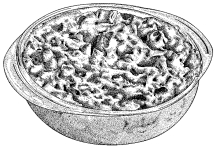 others deliver good flavor for a tiny price. With the cost of real cheese being what it is, the little packets of powdered cheese sauce are minuscule by comparison. If your kids have become accustomed to expensive “shells and cheese” dinners, you have some options. Start off by eliminating all mac & cheese from your menus. Go without it completely for at least 4 weeks, and 12 weeks if necessary. Then casually cook up a box of the cheap stuff. Nine times out of 10 they’ll gobble it up with gusto. This is the way we solved the “shells and cheese” dilemma at my house and it worked beautifully. I will never buy another box of that stuff in my life. It costs a full $1.50 for 3 servings. For that price I can make 14 servings of the cheap stuff. Mac & Cheese with packets of powdered cheese are one of the great convenience foods of our times.
others deliver good flavor for a tiny price. With the cost of real cheese being what it is, the little packets of powdered cheese sauce are minuscule by comparison. If your kids have become accustomed to expensive “shells and cheese” dinners, you have some options. Start off by eliminating all mac & cheese from your menus. Go without it completely for at least 4 weeks, and 12 weeks if necessary. Then casually cook up a box of the cheap stuff. Nine times out of 10 they’ll gobble it up with gusto. This is the way we solved the “shells and cheese” dilemma at my house and it worked beautifully. I will never buy another box of that stuff in my life. It costs a full $1.50 for 3 servings. For that price I can make 14 servings of the cheap stuff. Mac & Cheese with packets of powdered cheese are one of the great convenience foods of our times.
CRACKERS, CHIPS & SNACKS
Saltines, Graham Crackers & Animal Crackers are all reasonably priced when purchased in store-brands. The most they should cost you, even during these days of inflation, is $1 a pound. If you can’t find them for this little, then check your local Dollar Store, Wal-Mart or Aldis. 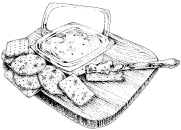 Saltines are incredibly versatile. Click here for some tried and true ideas. Also remember that they are quite good all by themselves. We often overlook the tasty simplicity of 5 or 6 saltines and a cup of hot tea or hot chocolate when a snack is in order but there is no time to cook.
Saltines are incredibly versatile. Click here for some tried and true ideas. Also remember that they are quite good all by themselves. We often overlook the tasty simplicity of 5 or 6 saltines and a cup of hot tea or hot chocolate when a snack is in order but there is no time to cook.
Graham and Animal Crackers are the dessert versions of saltines. Graham crackers can be spread with leftover frosting, whipped topping, peanut butter, cream cheese, jam, or almost anything spreadable. Top them with thin slices of banana or apple or sprinkle on raisins, nuts or seeds or even a drizzle of honey. Animal Crackers are best eaten plain with a frosty glass of reconstituted milk for a chaser.
If you have dietary limitations, then store-brand triscuit-like crackers can sometimes be found cheaply. Saltines with unsalted tops are also good 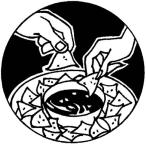 for those of us trying to reduce our sodium intake. They can be found in store-brands too, and can be used just like regular saltines.
for those of us trying to reduce our sodium intake. They can be found in store-brands too, and can be used just like regular saltines.
Other snacks that I sometimes make room for in my budget are pretzels and large bags of tortilla chips. I used to think that all chips were always bad buys. Several teenage boys I know were kind enough to teach me otherwise. 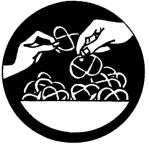 Their high metabolism and bottomless-pit-bellies demand quick snacks and extra calories. With this in mind I went on a quest for the best buys among the chips. I discovered that unit price, or the cost per ounce, is the key to making wise purchases in the chip aisle. Pretzels and tortilla chips can usually be found for 6¢ to 8¢ per ounce. They should never cost more than a dime per ounce. Tortilla chips are good for dipping in salsa, sour cream or yogurt-cheese, or melted velveeta-type cheese. They can also be sprinkled with shredded cheddar and
Their high metabolism and bottomless-pit-bellies demand quick snacks and extra calories. With this in mind I went on a quest for the best buys among the chips. I discovered that unit price, or the cost per ounce, is the key to making wise purchases in the chip aisle. Pretzels and tortilla chips can usually be found for 6¢ to 8¢ per ounce. They should never cost more than a dime per ounce. Tortilla chips are good for dipping in salsa, sour cream or yogurt-cheese, or melted velveeta-type cheese. They can also be sprinkled with shredded cheddar and 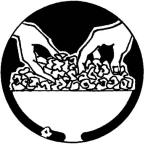 nuked until gooey. Pretzels are good plain, dipped in mustard or ranch dressing, and mixed in with your own homemade snack mix.
nuked until gooey. Pretzels are good plain, dipped in mustard or ranch dressing, and mixed in with your own homemade snack mix.
While on the subject, peanuts, sunflower seeds, cold cereal (in large bags) and plain popcorn are usually good snack buys. Popcorn is the cheapest, especially if you pop it yourself at home. Potato chips are just about the worst buy in the snack aisle. Five ounces for $2 is not a wise use of funds. Other chips and crackers should be measured against the standards mentioned above. If the unit price is low, they may be worth buying. If the unit price is high, pass them up and seek out the winners mentioned herein.
DRIED & CANNED BEANS
Believe it or not, dried beans were one of the earliest convenience foods. They could be safely stored for long periods  of time without deteriorating, were relatively light weight, and are easily prepared by anyone with 4 hours to watch a pot. These days though, we have something a bit faster: canned dried beans. The canned variety is certainly convenient: just open the can, season, heat and serve. This saves the work of soaking and simmering your own beans from scratch. While canned beans are relatively cheap, they cost at least twice or thrice as much as the dried variety. When every minute counts canned beans are a reasonable resource, especially when purchased at 3/$1. If you have the time though, you owe it to yourself to make them from scratch. They are lower in sodium and taste better too. Cooked beans can be frozen or home-canned with a pressure cooker for added time-savings. A 15-oz can of beans equals about 1-1/2 cups of cooked beans. Refried beans also save the time of mashing the beans into a thick paste, and my oldest son loves them, so I tend to indulge him on this point.
of time without deteriorating, were relatively light weight, and are easily prepared by anyone with 4 hours to watch a pot. These days though, we have something a bit faster: canned dried beans. The canned variety is certainly convenient: just open the can, season, heat and serve. This saves the work of soaking and simmering your own beans from scratch. While canned beans are relatively cheap, they cost at least twice or thrice as much as the dried variety. When every minute counts canned beans are a reasonable resource, especially when purchased at 3/$1. If you have the time though, you owe it to yourself to make them from scratch. They are lower in sodium and taste better too. Cooked beans can be frozen or home-canned with a pressure cooker for added time-savings. A 15-oz can of beans equals about 1-1/2 cups of cooked beans. Refried beans also save the time of mashing the beans into a thick paste, and my oldest son loves them, so I tend to indulge him on this point.
Quick Soak Method for Beans: Cover your beans with a few inches of water. Bring them to a boil and put a lid on the pot. Turn off the heat and allow the beans to soak for an hour. Drain and cover the plumped up beans with fresh water. Simmer on the back of the stove for an hour or two, or until tender. Season and use as desired.
Overnight Soak Method for Beans: Cover your beans with a few inches of water. Soak them overnight. The next day drain them, cover them with fresh water and simmer for an hour or two, or until tender. Season and use as desired.
FROZEN VEGETABLES
I love frozen vegetables. They often cost less than their fresh counterpart plus all of the work of cleaning, slicing, peeling, stringing and scraping is already done. Simply plop the veggies into boiling water or in the top of a steamer pan and within 5 minutes fresh, hot, crunchy veggies are ready for the family. The main convenience for frozen vegetables is the work they save. They are also handy to keep around because they store in the freezer for a full year if necessary. This means that when there is extra cash in the budget you can stock up without worrying about waste. The only bad buys among frozen veggies are carrots, which are almost always cheaper when purchased fresh in 5lb bags, and any frozen vegetable in a sauce. You pay the same premium price per pound for the sauce as you do for the vegetable. Plain frozen vegetables are always a better buy. Make your own sauces and save yourself a ton of money.
peeling, stringing and scraping is already done. Simply plop the veggies into boiling water or in the top of a steamer pan and within 5 minutes fresh, hot, crunchy veggies are ready for the family. The main convenience for frozen vegetables is the work they save. They are also handy to keep around because they store in the freezer for a full year if necessary. This means that when there is extra cash in the budget you can stock up without worrying about waste. The only bad buys among frozen veggies are carrots, which are almost always cheaper when purchased fresh in 5lb bags, and any frozen vegetable in a sauce. You pay the same premium price per pound for the sauce as you do for the vegetable. Plain frozen vegetables are always a better buy. Make your own sauces and save yourself a ton of money.
CANNED SPAGHETTI SAUCE
Spaghetti Sauce purchased in tall 26-ounce cans are one of the best bargains in the supermarket these days. 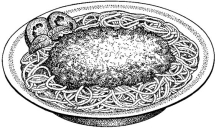 They usually cost about the same as an equivalent amount of canned tomatoes. All of the work of preparing the tomatoes, seasoning the sauce and simmering it on the back of the stove for an hour, is already done for you. Spaghetti sauce in jars is never as a good a buy as the canned variety. At our house we use it for homemade pizza, for quickie meals of spaghetti with tomato sauce, and as a nice sauce on baked chicken leg-quarters. It’s quick, it’s easy and it doesn’t cost any more than plain tomatoes. The sugar-free variety is great for special diets, and the variety of flavors means everyone can find a favorite. These qualities make it a real winner in my book.
They usually cost about the same as an equivalent amount of canned tomatoes. All of the work of preparing the tomatoes, seasoning the sauce and simmering it on the back of the stove for an hour, is already done for you. Spaghetti sauce in jars is never as a good a buy as the canned variety. At our house we use it for homemade pizza, for quickie meals of spaghetti with tomato sauce, and as a nice sauce on baked chicken leg-quarters. It’s quick, it’s easy and it doesn’t cost any more than plain tomatoes. The sugar-free variety is great for special diets, and the variety of flavors means everyone can find a favorite. These qualities make it a real winner in my book.
CANNED OR FROZEN FRUIT JUICE CONCENTRATE
Concentrated fruit juice saves both time and money over preparing juice from scratch. Fresh squeezed orange juice is delicious, 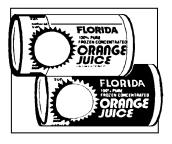 and it’s a great way to use up aging oranges, but it almost always costs more than frozen concentrated orange juice. Preparing juice from concentrate is quick and easy while being a national goldmine. These days almost all juice concentrate is fortified with Vitamin C. Orange juice can be found fortified with calcium too. For the lactose intolerant among us, this is a nice benefit. Generally the least expensive frozen juices are orange, apple, grapefruit and purple grape. Canned juice concentrates are also available in soda-pop sized cans. They are reconstituted just like the frozen variety. Apple, purple grape, white grape and berry flavors are usually inexpensive. Concentrated fruit juice almost always costs less than regular strength juice in cans, jugs and jars. The only exception I’ve found is 48-ounce jars of apple juice on sale. Be sure to read labels when you compare juice prices. You want 100% real juice, not fruit juice cocktail. Juice cocktails only contain a small percentage of fruit juice and a bucket load of sugar. They are never a good buy.
and it’s a great way to use up aging oranges, but it almost always costs more than frozen concentrated orange juice. Preparing juice from concentrate is quick and easy while being a national goldmine. These days almost all juice concentrate is fortified with Vitamin C. Orange juice can be found fortified with calcium too. For the lactose intolerant among us, this is a nice benefit. Generally the least expensive frozen juices are orange, apple, grapefruit and purple grape. Canned juice concentrates are also available in soda-pop sized cans. They are reconstituted just like the frozen variety. Apple, purple grape, white grape and berry flavors are usually inexpensive. Concentrated fruit juice almost always costs less than regular strength juice in cans, jugs and jars. The only exception I’ve found is 48-ounce jars of apple juice on sale. Be sure to read labels when you compare juice prices. You want 100% real juice, not fruit juice cocktail. Juice cocktails only contain a small percentage of fruit juice and a bucket load of sugar. They are never a good buy.
When you need a side dish in a flash,
Don’t worry, you don’t have to dash.
Make instant ‘taters in your pot,
And quickly fill your hungry tots.
YUM!
Okay, poetry may not be my ultimate calling in life, buy you get the idea. Instant mashed potatoes are filling and taste good. 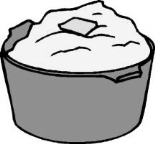 They save the time of peeling, chopping, boiling and mashing potatoes from scratch, or about 45 minutes of work. They are relatively nutritious, containing moderate amounts of Vitamin C and Potassium. In addition, they are popular with most families, especially children. Fresh mashed potatoes taste better and are more nutritious, but they can’t be fixed from beginning to end, in less than 5 minutes flat! Recently I’ve seen several packages of flavored instant potatoes. Don’t waste your time or money on them. Plain instant potatoes are you best buy. It is easy as pie to add garlic powder, sour cream, or cheese to your own mashed potatoes. Doing it yourself saves lots of money and doesn’t take much extra time, perhaps a minute at most. If you are really pressed for time, try making your own Garlic Mashed Potato Mix.
They save the time of peeling, chopping, boiling and mashing potatoes from scratch, or about 45 minutes of work. They are relatively nutritious, containing moderate amounts of Vitamin C and Potassium. In addition, they are popular with most families, especially children. Fresh mashed potatoes taste better and are more nutritious, but they can’t be fixed from beginning to end, in less than 5 minutes flat! Recently I’ve seen several packages of flavored instant potatoes. Don’t waste your time or money on them. Plain instant potatoes are you best buy. It is easy as pie to add garlic powder, sour cream, or cheese to your own mashed potatoes. Doing it yourself saves lots of money and doesn’t take much extra time, perhaps a minute at most. If you are really pressed for time, try making your own Garlic Mashed Potato Mix.
HOT DOGS & BALONEY
All right, in today’s politically correct days the health food police are telling us all to stop eating hotdogs and 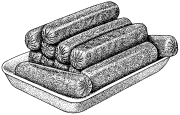 baloney because they are high in fat, chock full of preservatives, and provide only dubious amounts of nutrition. I suspect these folks have never struggled to make ends meet because if they had, they would know that there is a time and place for these things in a limited budget. The least expensive types of lunch meat are usually made from chicken or turkey. This turns out to be a good thing health-wise because they contain 40% less fat than their pork or beef relatives.
baloney because they are high in fat, chock full of preservatives, and provide only dubious amounts of nutrition. I suspect these folks have never struggled to make ends meet because if they had, they would know that there is a time and place for these things in a limited budget. The least expensive types of lunch meat are usually made from chicken or turkey. This turns out to be a good thing health-wise because they contain 40% less fat than their pork or beef relatives. 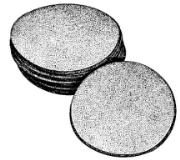 Chicken baloney and hot dogs can be widely purchased for about $1 a pound. They are high in protein, taste good and have moderate amounts of fat. Hot dogs are handy for quick snacks and meals and are so versatile that you can find an article about them by Clicking Here. Baloney is not quite as versatile but it still has it’s uses. It can be fried and served at breakfast or placed on a sandwich with egg or cheese. Cut into triangles it is yummy on crackers or fried and arranged on homemade pizza. The classic way to eat baloney is on white bread with mayo and mustard. A slice of cheese and maybe some lettuce or tomato are nice additions, but not really necessary for a good sandwich.
Chicken baloney and hot dogs can be widely purchased for about $1 a pound. They are high in protein, taste good and have moderate amounts of fat. Hot dogs are handy for quick snacks and meals and are so versatile that you can find an article about them by Clicking Here. Baloney is not quite as versatile but it still has it’s uses. It can be fried and served at breakfast or placed on a sandwich with egg or cheese. Cut into triangles it is yummy on crackers or fried and arranged on homemade pizza. The classic way to eat baloney is on white bread with mayo and mustard. A slice of cheese and maybe some lettuce or tomato are nice additions, but not really necessary for a good sandwich. 
CONDIMENTS
These are things like pickles, mayonnaise, ketchup, salsa and mustard. A hundred years ago every housewife worth her salt prepared or canned these items herself. Today we don’t have to do that. They are available inexpensively, and save a ton of work over making them from scratch. A few women still make these at home themselves, but no one thinks less of you if you use the store-bought versions. Check the store-brands and off-brands, especially in large sizes, for the smallest price per ounce. Reduced fat mayonnaise is usually available in a store-brand, so it doesn’t cost any extra. In case you can’t find it in your area, then try combining plain nonfat yogurt and regular mayonnaise half and half. The resulting dressing tastes good and has half the fat and calories of normal mayo. It can be used in dips, as a spread or pretty much anywhere you would use reduced fat mayonnaise. Reduced sugar or low sodium ketchup costs more than the standard varieties, but may be worth it to you if you are on a special diet. A fast and inexpensive alternative is to make you own ketchup and adjust the salt or sugar to accommodate your needs.
BOUILLON CUBES, BROTH POWDER & STOCK
These are a real staple in my home. In fancy French kitchens freshly made stock is always available for soups and sauces, which is one of the secrets to their cuisine. In my kitchen I prefer the ease, convenience and low cost of bouillon cubes. 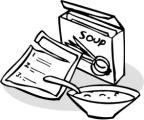 I usually buy large jars of both beef and chicken bouillon cubes from my local warehouse store. They last a couple of years and give me week upon week of tasty broth. I also use ham and veggie broth powders when I can find them, although they’re not as versatile as the others. Another handy item to have on hand is onion soup mix. I am willing to pay 50¢ a box but much more than that puts it out of my price range.
I usually buy large jars of both beef and chicken bouillon cubes from my local warehouse store. They last a couple of years and give me week upon week of tasty broth. I also use ham and veggie broth powders when I can find them, although they’re not as versatile as the others. Another handy item to have on hand is onion soup mix. I am willing to pay 50¢ a box but much more than that puts it out of my price range.
Some recipes call for canned consomme. To make your own simply use twice as much bouillon as you normally would. For instance, 1-cup of consomme is made by dissolving 2 bouillon cubes or 2 teaspoons of broth powder in 1 cup of boiling water. If you prefer a richer product, you can also dissolve a small amount (1/2-teaspoon) of unflavored gelatin in the broth. This isn’t necessary, but it does improve the texture somewhat. If you are on a low-sodium diet then packets of low-sodium broth are quite delicious. They cost a little more than the cheap high-sodium ones, but are still much cheaper than canned broth.
Canned broth is a BIG waste of money. 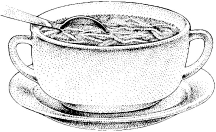 The flavor is insipid. It tastes like the shadow of a chicken was waved over a gallon of water and canned in a factory to sell to foolish women who don’t know any better. If you must have real broth then make your own chicken stock. Boil up any chicken bones, skin and fat that you have leftover from normal kitchen use. Chicken bones that have been gnawed on by the family can still make good stock. Just boil everything in a big pot for a couple of hours. Then strain off the solids and toss them out. Chill the remaining broth in the fridge overnight. In the morning remove the big cake of fat that will have risen to the top and what you have left is 99% fat free, honest to goodness, homemade chicken stock. Use it in soups, sauces or anywhere else you would use the canned variety. It should be frozen for long term keeping, as it only keeps for a few short days in the fridge. Reboil it every couple of days for longer keeping. I usually salt my homemade broth with bouillon cubes to give an even richer flavor to the broth.
The flavor is insipid. It tastes like the shadow of a chicken was waved over a gallon of water and canned in a factory to sell to foolish women who don’t know any better. If you must have real broth then make your own chicken stock. Boil up any chicken bones, skin and fat that you have leftover from normal kitchen use. Chicken bones that have been gnawed on by the family can still make good stock. Just boil everything in a big pot for a couple of hours. Then strain off the solids and toss them out. Chill the remaining broth in the fridge overnight. In the morning remove the big cake of fat that will have risen to the top and what you have left is 99% fat free, honest to goodness, homemade chicken stock. Use it in soups, sauces or anywhere else you would use the canned variety. It should be frozen for long term keeping, as it only keeps for a few short days in the fridge. Reboil it every couple of days for longer keeping. I usually salt my homemade broth with bouillon cubes to give an even richer flavor to the broth.
DESSERTS
Most desserts are best made from scratch. A few though, are reasonably priced and save time as well.  Instant Pudding Mix is my favorite dessert convenience food. It can be made in about 5 minutes, from start to clean-up, and it’s a real family pleaser. The time savings over making your own pudding from scratch is about 15 minutes, and the price is very similar assuming you’re able to find them 3 for a $1. When made with reconstituted milk, four servings can be made for less than 50¢. Prepared pudding in cups cost over twice as much and don’t taste half as good. Plus the servings are smaller, making them a really bad buy. Other good buys include
Instant Pudding Mix is my favorite dessert convenience food. It can be made in about 5 minutes, from start to clean-up, and it’s a real family pleaser. The time savings over making your own pudding from scratch is about 15 minutes, and the price is very similar assuming you’re able to find them 3 for a $1. When made with reconstituted milk, four servings can be made for less than 50¢. Prepared pudding in cups cost over twice as much and don’t taste half as good. Plus the servings are smaller, making them a really bad buy. Other good buys include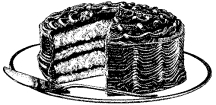 chocolate frosting at $1 a tub and whipped topping at $1.50 for the large tub. Vanilla frosting is not as good a buy as chocolate frosting because we must factor in the price of cocoa. It does save time though, and some women find it indispensable. Homemade frosting from scratch tastes better than store-bought, but the price really isn’t that much more. Whipped topping can be made at home from this recipe, or you can buy it ready-made from your grocer’s freezer. At 10¢ an ounce or less, it saves the work of making it yourself. The only drawback is the bucketload of chemicals used to make it stable, but if you’re already eating hot dogs and baloney then you may be able to overlook the chemicals in frozen whipped topping because of it’s ease of use. In case you can’t make yourself overlook the chemical feast, then get friendly with the recipe linked above. Another great buy in the frozen food aisle is ice cream. If you can find it for between $2 & $2.50 per half gallon, then consider yourself lucky and stock up.
chocolate frosting at $1 a tub and whipped topping at $1.50 for the large tub. Vanilla frosting is not as good a buy as chocolate frosting because we must factor in the price of cocoa. It does save time though, and some women find it indispensable. Homemade frosting from scratch tastes better than store-bought, but the price really isn’t that much more. Whipped topping can be made at home from this recipe, or you can buy it ready-made from your grocer’s freezer. At 10¢ an ounce or less, it saves the work of making it yourself. The only drawback is the bucketload of chemicals used to make it stable, but if you’re already eating hot dogs and baloney then you may be able to overlook the chemicals in frozen whipped topping because of it’s ease of use. In case you can’t make yourself overlook the chemical feast, then get friendly with the recipe linked above. Another great buy in the frozen food aisle is ice cream. If you can find it for between $2 & $2.50 per half gallon, then consider yourself lucky and stock up.  It is delicious on fruit crisps, in sundaes and as a refreshing dessert in the heat of summer. Making it yourself is complicated and requires special equipment. For most of us, if we can’t buy it from the store, then we won’t be able to eat it very often. If your main use of ice cream is for milk shakes, then try my recipe for Magic Milk Shakes that are made in a blender and don’t require ice cream. Finally, fruit flavored gelatin mix, when found at 3/$1 adds variety to our diet. I don’t really like them because they are completely empty calories. I prefer to buy unflavored gelatin and make my own “gell-o” with fruit juice. It doesn’t take any more time, and you know it is supplying the family with much needed nutrition. If you love gelatin though, then it can be used as desired.
It is delicious on fruit crisps, in sundaes and as a refreshing dessert in the heat of summer. Making it yourself is complicated and requires special equipment. For most of us, if we can’t buy it from the store, then we won’t be able to eat it very often. If your main use of ice cream is for milk shakes, then try my recipe for Magic Milk Shakes that are made in a blender and don’t require ice cream. Finally, fruit flavored gelatin mix, when found at 3/$1 adds variety to our diet. I don’t really like them because they are completely empty calories. I prefer to buy unflavored gelatin and make my own “gell-o” with fruit juice. It doesn’t take any more time, and you know it is supplying the family with much needed nutrition. If you love gelatin though, then it can be used as desired.
EVAPORATED MILK, POWDERED MILK & BUTTERMILK
Powdered milk is my A #1 favorite convenience food ever. It’s fat-free, tastes good and keeps for a very long time. 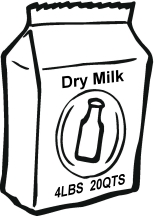 I use it in cooking, for drinking and anywhere else I can. If you think powdered milk tastes icky, then your box of it is probably very old. Toss it out, buy a fresh box and mix up a pitcher full of frosty reconstituted milk. Once opened, dry milk tastes best if used within 3 or 4 months. Unopened it tastes best if used within a year. Even if it begins to take on a stale flavor, it is still good in cooking, where the flavor is less noticeable. Click Here for lots of information on delicious powdered milk.
I use it in cooking, for drinking and anywhere else I can. If you think powdered milk tastes icky, then your box of it is probably very old. Toss it out, buy a fresh box and mix up a pitcher full of frosty reconstituted milk. Once opened, dry milk tastes best if used within 3 or 4 months. Unopened it tastes best if used within a year. Even if it begins to take on a stale flavor, it is still good in cooking, where the flavor is less noticeable. Click Here for lots of information on delicious powdered milk.
Evaporated whole milk is another great buy. It’s rich, full bodied texture and flavor make it a great substitute for heavy cream. It can even be whipped if well chilled first. When diluted with an equal amount of water you have the equivalent of whole milk. It won’t taste the same for drinking, but it is excellent for cooking and making scrumptious hot chocolate. It’s good in coffee or tea and costs less than fresh whole milk. Plus it sits 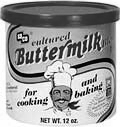 on the shelf for a year or longer without going bad. Definitely worth keeping on hand.
on the shelf for a year or longer without going bad. Definitely worth keeping on hand.
Powdered buttermilk is available in the baking aisle of most supermarkets under the SACO brand. It costs less than fresh buttermilk and stores more easily. It can be used anywhere fresh buttermilk is used, even for making fruit smoothies and buttermilk ranch dressing. If you like to make your own baking mixes it’s handy to keep on hand. I always make my homemade biscuits with powdered buttermilk and folks are always telling me how good they are. Not everyone will find powdered buttermilk as useful as I do. If you never use buttermilk then it will not be a good buy for you. If you do use buttermilk though, and hate having 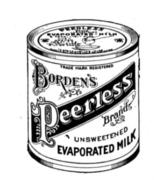 a quart of it in the fridge for a month or longer, then you’ll find the convenience of preparing only a small amount at a time, much to your liking.
a quart of it in the fridge for a month or longer, then you’ll find the convenience of preparing only a small amount at a time, much to your liking.
While on the subject, coffee lightener, or nondairy powdered creamer, can be very useful when used in conjunction with dry milk. I use it like a powdered cream to add body and richness to homemade drink mixes that are based on powdered milk. To make liquid non-dairy creamer, combine 1/4 cup powdered creamer with 1/2 cup hot tap water. Stir well. Add a drop or 2 of vanilla flavoring and chill until serving time. This is the equivalent of French Vanilla Creamer, only yours tastes better, and costs a fraction of the refrigerated version on the grocer’s shelf.
DRIED EGG WHITES
Just Whites is the only brand name that I’ve seen. It comes in a 7 or 8-ounce tub and has the equivalent of about 60 egg whites in it.  While dried egg whites aren’t as cheap as eggs on sale, they are not overly expensive either, especially considering that there is no waste. If you are on a low cholesterol diet dried egg whites are obviously a great alternative to eggs. Their real beauty though is that they can be included in your own homemade baking or pancake mixes. They are cholesterol and fat free, but still supply all of the good emulsion properties of whole eggs. They can even be whipped into peaks and meringues. Another good use is to add a small amount to homemade frosting. It improves the texture and spread-ability of your finished product. Like dried buttermilk, dried egg whites are not something that everyone will need. For homemade mixes they are great and for some people they will be handy to have in the cupboard.
While dried egg whites aren’t as cheap as eggs on sale, they are not overly expensive either, especially considering that there is no waste. If you are on a low cholesterol diet dried egg whites are obviously a great alternative to eggs. Their real beauty though is that they can be included in your own homemade baking or pancake mixes. They are cholesterol and fat free, but still supply all of the good emulsion properties of whole eggs. They can even be whipped into peaks and meringues. Another good use is to add a small amount to homemade frosting. It improves the texture and spread-ability of your finished product. Like dried buttermilk, dried egg whites are not something that everyone will need. For homemade mixes they are great and for some people they will be handy to have in the cupboard.
To support the blog, check out the HBHW eBooks available on Amazon. Thank you!
Disclosure: Some of the links below are affilate links, meaning, at no additional cost to you, I will earn a commission if you click through and make a purchase.

